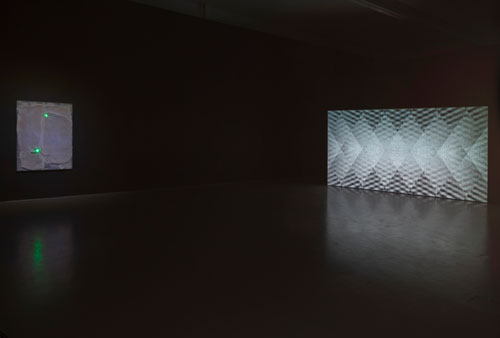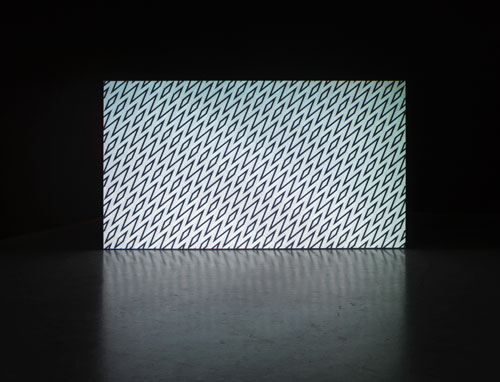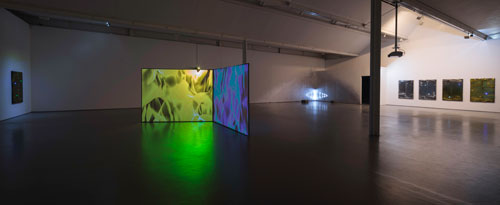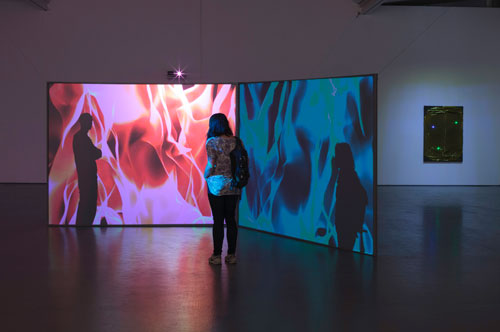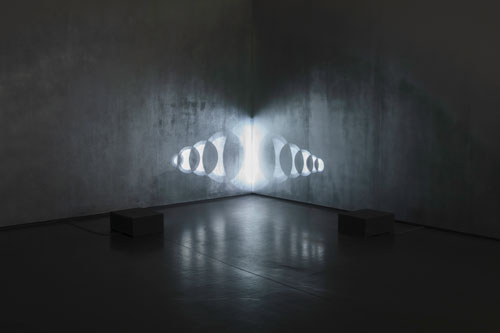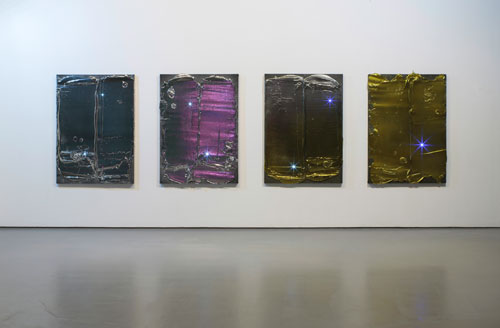

Dundee Contemporary Arts
7 February – 22 March 2015
by DARRAN ANDERSON
It is arguable that art should have no obligations beyond creative expression, yet one profound function it possesses is the ability to recontextualise. Take static; a banal sign of transmission failure and, to most, a source of infuriation. If it is reminiscent of anything, it is limbo, the negative space between signals, an articulation of nothingness in two dimensions. Yet there are foreign interpretations that are oddly poetic – the view of it as a blizzard, visual noise or “a war of the ants”. With the switch to digital from analogue, static has effectively disappeared and perhaps, as with all outmoded technology, there might now be some latent nostalgia for this version of the void, especially when we consider a fraction of it came from cosmic radiation left by the Big Bang. The point is that a change of perspective can instil even mundane signs of malfunction with meaning and resonance. It helps us to see how unusual the familiar really is.
The works of Florian and Michael Quistrebert (born in 1982 and 1976 respectively) exist manifestly in and of themselves. They seek not just to suggest the void, but to embody it. Theirs is, by their own admission, an art that aims to be an experience rather than clever or indulgent concepts to ponder. They intend the viewer primarily to feel rather than think. It is worth noting that for all the philistine opposition to conceptual art, the idea of art that is visceral and moves away from, or beyond, thought is potentially even more divisive. The brilliance of the Quistrebert brothers’ work is that you very easily go along with it, if you allow yourself. Their art is enticing, absorbing and, almost despite themselves, provokes a multitude of thoughts.
Entering the darkened gallery, the immediate attraction, dazzling in the half-light, is Stripes 2 (2013), a hypnotic revelation of a projection in the centre of the room. Initially appearing as static on a large screen, it is soon apparent that this is a visual universe. Here we have a piece that resembles the soul of mathematics with continually changing, puzzling, awe-inspiring patterns. The effect of viewing it up close, particularly with your silhouette cast on to the screen, is dissociative. It is all monochrome vectors, fractals and mandalas, continually altering, developing and multiplying. The mind struggles to keep up with an intricate harmonious cacophony of pattern, which coalesces and falls away again into apparent chaos, like a sea of information. It is op art with the crucial addition of time, a viral geometry that would appear Zen were it not so exquisitely unsettling. A photo at any stage in the flux of the piece would stand alone as a work of art, but the Quistrebert brothers have the confidence to let it flow and let the audience be pulled along with it.
The 8th Sphere (2010) occupies a corner of the gallery. It, too, is hypnotic and could be frozen at any stage to capture a glorious image painted in light, with echoes of orphism, suprematism and Afrofuturism. The work is a living piece in which motion is crucial. Pyramids morphing within pyramids appear, both ancient and alien. Circles ripple outwards, but in ways no liquid conceivably could. Nothing stays the same. Everything is changing. This observation, never forced or even clearly articulated, nevertheless seems at the core of their work. These pieces are reflections of a universe where the only certainty is change and where the only meaning is that projected on to it by the viewer (the 8th Sphere being an occult theory of a realm “visible only to visionary-imaginative clairvoyance”, in the words of Rudolf Steiner). The shapes and movement may be sublime or foreboding, according to how they are viewed, but they are insentient. They exist, however fleetingly, as part of a process and without the need to explain. The audience are afforded no luxuries, damned as we are to continually search for meaning.
With the large video triptych Void Fires (2015), the Quistrebert brothers underline how we think we extract meaning when really we impose it. The screens are filled with flickering flames of varying hues, suggesting both the Inferno and the life-giving properties of the sun. The colours, in fact, have been developed from brands of energy drink. The sublime meets the facile. This could be seen as a barbed comment, but it is insightful essentially because this is how life works, and our process of categorising and selective editing to fit our preferred narratives is a deceitful one.
In their Overlight series of paintings, LEDs shine out of, and over, the surfaces of the works. This alters the appearance from being almost topographical to metallic and melting. Figures, landscapes, scrolls, disaster zones or carapaces might be discerned. As with all the works on show, they feel totemic and ritualistic, strange relics of a forgotten or newly created religion. A ceremonial feel runs right through the exhibition. These are symbols floating in search of a meaning and we cannot help but provide them. There is no harm in this, of course, and it might even be said that the birth of beliefs in a cold nihilistic universe is an admirable artistic act. It is when we start to believe in the faiths we have taken from the chaos and, furthermore, insist that others agree that the problems arise. Yet there is discernible meaning beyond myth in the works; in the materiality of the Overlight paintings, in the mathematical loops and patterns of the videos that suggest, in the old Existentialist sense, that there is no meaning bar the meaning we construct for ourselves. Considering the alternatives, we have little option but to do so.
Visions of Void is an exceptionally focused, enthralling, atmospheric and, though it might be missed in the experience-driven environment, a beautifully drafted exhibition by the Quistrebert brothers and the DCA. If it fails anywhere, it is in fulfilling its title. While the artists certainly produce visions of the void, their real victory is to prove that there can be no such thing, so long as there is someone there to view it. For as long as humanity survives, we will be deciphering shapes, beliefs and emotions from the light and the shadows, even if they are rarely as mesmerising as these.
